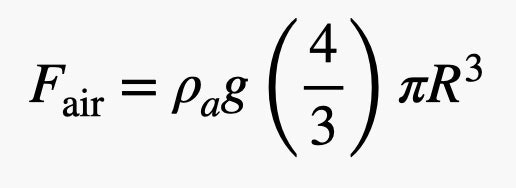This works for any shaped object where V is the volume. Notice that this total force from the air only depends on collisions between the air molecules and the surface. It doesn’t matter what the balloon is made of or what it’s filled with. Only the volume matters.
Then why does a party balloon float but a basketball of about the same size falls? It has to do with whether the upward-pushing buoyancy force is enough to overcome the gravitational force that is pulling the object downwards.
Let’s put in some numbers. Let’s assume both a basketball and a balloon have a diameter of 20 cm. Calculating the volume and plugging into the Fair equation, I get an upward-pushing force of 0.049 newtons. That’s tiny.
But the rubber shell of a balloon is thin, so the gravitational force is not very large. And if you fill it with helium, a gas that has a lower density than air, you can compensate for the mass of the balloon’s thin surface and achieve equilibrium. If you can get the mass of the rubber plus the helium gas to be the same as the upward-pushing buoyancy force, the balloon floats.
It doesn’t matter what you put in the basketball; it will still fall. The rubber shell of the basketball is much thicker and heavier than the wall of the balloon. The tiny buoyancy force is essentially insignificant compared to gravity’s pull on an object with this mass, and it can’t overcome it. So the ball drops.
Building Your Floating Hideout
Now, let’s work on your supervillain lair. Ryan North claims that if you make a hollow metal sphere big enough, you can turn it into a secret floating base to use while you try to take over the world. Or maybe you just want to hang out there, I don’t know.
Is that actually possible?
Let’s make a spherical object and see if it floats. Remember that for the object to float, its weight must be equal to the weight of the air displaced. For this object, it’s going to have two parts—the outer shell and the interior gas. The interior gas will have a radius of R and density ρ~1~. The shell has a thickness of t with a density of ρ2.
The first (and simple) thing to calculate is the buoyancy force. This just depends on the volume of the whole sphere, which has a radius of R + t. But if we are going to get this super villain base, it will only work with a thin shell. That means we can just say the radius of the whole thing is the same as the radius of the interior (R).
Illustration: Rhett Allain



